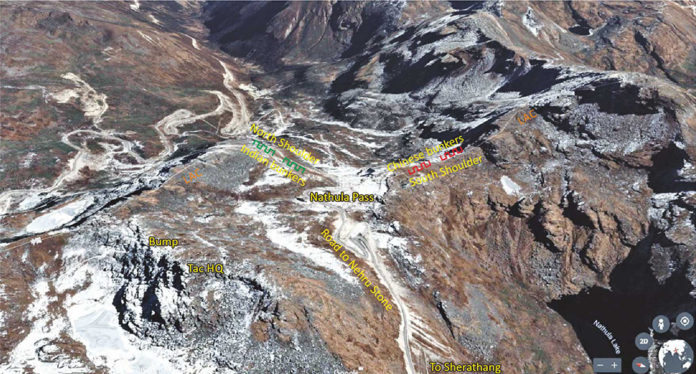During the 1965 War between India and Pakistan, China served an ultimatum demanding that India withdraw her posts from Nathu La and Jelep La in Sikkim. In the 17 Mountain Division sector, the main defences were at Changgu, while Nathula was only an observation post. In case of hostilities, the division commanders had been given the authority to vacate the posts and fall back on the main defences. Maj Gen Sagat Singh, GOC 17 Division, did not agree with the views of the Corps HQ. Vacating the passes would give the Chinese the tactical advantage of observation and fire into India, while denying the same to our own troops.
In the event, 27 Division vacated Jelep La, which the Chinese promptly occupied. However, Nathu La remained in Indian hands.
In the first week of August 1967, the border outposts (BOPs) at Nathu La were occupied by 2 Grenadiers, under Lt Col Rai Singh, relieving 18 Rajput. Maj Bishan Singh took over as ‘Tiger Nathu La’. The deployment at Nathu La comprised a platoon each on Camel’s Back, South Shoulder, Centre Bump and Sebu La. The battalion HQ was at GoleGhar, while the 3-inch mortars and administrative base were at Sherabthang.
On 13 August the observation post at Sebu La reported that the Chinese had arrived on the crest line and dug trenches on our side of the IB. When challenged, they filled up the trenches and withdrew. 2 Grenadiers was ordered to lay a three-strand wire fence along the border from Nathu La towards the North Shoulder. However, as soon as work began on the fence on 20 August, the Chinese became agitated and asked the Indians to stop.
On 23 August, Major Bishan Singh reported that about 75 Chinese in battle dress carrying rifles fitted with bayonets were advancing towards Nathu La. They started shouting slogans. Indian troops were ‘standing to’, watching and waiting. After standing on the border for about an hour the Chinese withdrew and all was quiet again.
Fron 2 to 7 September, efforts were made to contruct the bard wire fence and objected by the Chinese every time. At one time Major Bishan and his men were detained but they pushed their way through the Chinese and returned to Nathu La.
On 7 September work started again on laying the wire and it resulted in hand-to-hand fighting and the Chinese pelting stones. The Grenadiers responded in the same manner. On 10 September, Sagat held a conference at the Brigade HQ in Changgu, where he personally briefed everyone on how the operation for constructing the fence was to be carried out next morning. One company of 18 Rajput was brought in to reinforce the defences. An ad hoc force of 90 men was organised into a protection party to charge the Chinese positions if they opened fire. A pioneer platoon was to assist the platoon of 70 Field Company, to lay the wire.
As soon as work commenced on 11 September, the Chinese came up to the fence and tried to stop it. As the arguments became more heated, tempers rose, with both sides standing their ground. Suddenly, the Chinese opened fire, causing several casualties among the troops working on the wire fence. Lt Col Rai Singh was hit by a Chinese bullet and fell down.
Seeing their CO fall, the Grenadiers became mad with rage. In a fit of fury, they came out of their trenches and attacked the Chinese post, led by Capt PS Dagar. The company of 18 Rajput, under Maj Harbhajan Singh and the sappers and pioneers working on the fence had been caught in the open and suffered heavy casualties from the Chinese firing. Realising that the only way to neutralise the Chinese fire was a physical assault, Harbhajan led a charge on the Chinese position. Several of the Indian troops were mowed down by Chinese machine guns, but those who reached the Chinese bunkers used their bayonets and accounted for many of the enemy. Both Harbhajan and Dagar lost their lives in the action, which developed into a full scale battle, lasting six days. Sagat had asked for some medium guns and these were moved up to Kyangnosala, at a height of over 10,000 ft. The artillery OPs proved their worth in bringing down effective fire on the Chinese. Because of lack of observation and the steep incline west of Nathula, most Chinese shells fell behind the forward defences and did not harm the Indians.
The skirmish at Nathula lasted six days. The Indian casualties in the action were just over two hundred – 65 dead and 145 wounded. The Chinese are estimated to have suffered about 300 casualties.


















